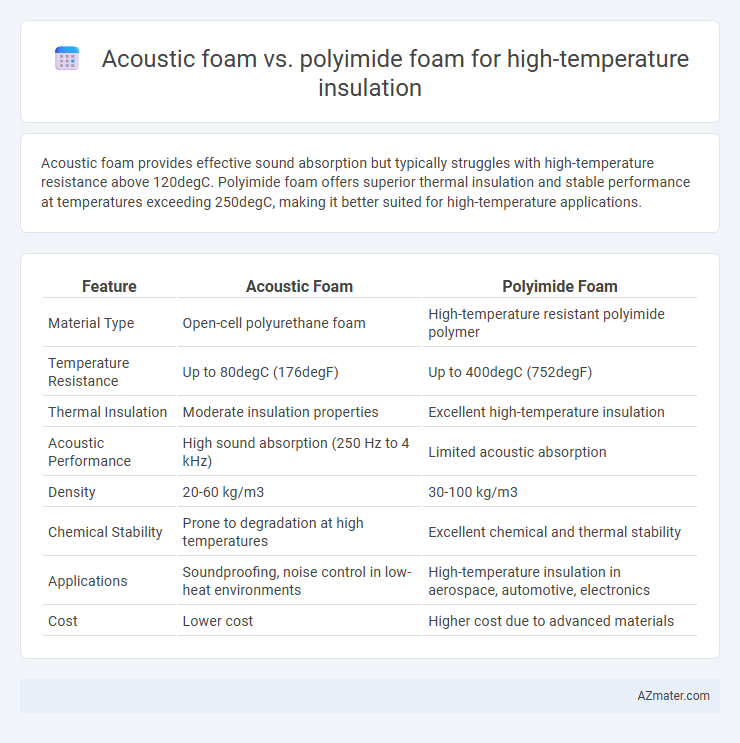Acoustic foam provides effective sound absorption but typically struggles with high-temperature resistance above 120degC. Polyimide foam offers superior thermal insulation and stable performance at temperatures exceeding 250degC, making it better suited for high-temperature applications.
Table of Comparison
| Feature | Acoustic Foam | Polyimide Foam |
|---|---|---|
| Material Type | Open-cell polyurethane foam | High-temperature resistant polyimide polymer |
| Temperature Resistance | Up to 80degC (176degF) | Up to 400degC (752degF) |
| Thermal Insulation | Moderate insulation properties | Excellent high-temperature insulation |
| Acoustic Performance | High sound absorption (250 Hz to 4 kHz) | Limited acoustic absorption |
| Density | 20-60 kg/m3 | 30-100 kg/m3 |
| Chemical Stability | Prone to degradation at high temperatures | Excellent chemical and thermal stability |
| Applications | Soundproofing, noise control in low-heat environments | High-temperature insulation in aerospace, automotive, electronics |
| Cost | Lower cost | Higher cost due to advanced materials |
Introduction to High-Temperature Insulation Materials
High-temperature insulation materials like acoustic foam and polyimide foam serve critical roles in thermal management across industries such as aerospace and electronics. Acoustic foam primarily reduces noise while offering moderate thermal resistance, but polyimide foam excels in high-temperature environments with stability up to 400degC and superior thermal insulation properties. Selecting between these foams depends on specific thermal conductivity, temperature thresholds, and fire-retardant requirements critical for maintaining safety and performance.
What is Acoustic Foam?
Acoustic foam is a porous material designed to absorb sound waves and reduce noise levels by trapping air within its open-cell structure, enhancing acoustic insulation. It is typically made from polyurethane or melamine and is effective for soundproofing but has limited thermal resistance, making it less suitable for high-temperature insulation applications. In contrast, polyimide foam offers superior heat resistance up to 400degC, making it ideal for high-temperature insulation while still providing moderate acoustic dampening.
What is Polyimide Foam?
Polyimide foam is a lightweight, high-performance material known for its exceptional thermal stability and flame resistance, making it ideal for high-temperature insulation applications. Unlike traditional acoustic foam, polyimide foam maintains structural integrity and insulation properties at temperatures exceeding 400degC (752degF), providing superior protection in aerospace, automotive, and industrial environments. Its closed-cell structure offers excellent sound absorption while resisting chemical degradation, oxidation, and mechanical stress under extreme thermal conditions.
Thermal Insulation Properties: Acoustic vs Polyimide Foam
Polyimide foam outperforms acoustic foam in high-temperature insulation due to its superior thermal stability, withstanding temperatures up to 400degC compared to acoustic foam's typical limit around 100degC. The low thermal conductivity of polyimide foam, often below 0.03 W/m*K, ensures efficient heat resistance in extreme environments, whereas acoustic foam primarily focuses on sound absorption and has higher thermal conductivity. In industrial and aerospace applications, polyimide foam's combination of lightweight structure and exceptional thermal insulation makes it preferable over conventional acoustic foam for high-temperature insulation needs.
Sound Absorption Capabilities Compared
Acoustic foam primarily focuses on sound absorption by trapping and dissipating airborne noise, making it effective in reducing echoes and reverberation in standard temperature environments. Polyimide foam exhibits moderate sound absorption capabilities but is engineered to withstand extreme temperatures up to 400degC or higher, offering a balance between thermal resistance and acoustic performance. For high-temperature insulation applications requiring sound absorption, polyimide foam provides durability with acceptable acoustic properties, whereas acoustic foam excels in acoustic treatment but lacks thermal stability.
Temperature Resistance and Stability
Polyimide foam exhibits superior temperature resistance compared to acoustic foam, maintaining structural integrity at temperatures exceeding 300degC, whereas typical acoustic foam degrades above 80-100degC. Its stability under extreme thermal conditions makes polyimide foam ideal for high-temperature insulation applications, including aerospace and industrial sectors. Acoustic foam, while effective for sound absorption, lacks the thermal resilience necessary for sustainable insulation in elevated temperature environments.
Fire Safety and Flame Retardancy
Acoustic foam typically consists of polyurethane, offering moderate fire resistance but prone to melting and emitting toxic fumes under high temperatures. Polyimide foam excels in high-temperature insulation with superior fire safety, exhibiting excellent flame retardancy and stability up to 400degC or higher without releasing hazardous gases. Its low smoke density and self-extinguishing properties make polyimide foam the preferred choice for critical applications requiring stringent fire safety standards.
Durability and Longevity in Harsh Environments
Polyimide foam offers superior durability and longevity in high-temperature insulation compared to acoustic foam, maintaining structural integrity and performance at temperatures exceeding 300degC. Acoustic foam, typically made from polyurethane or melamine, degrades faster under extreme heat and harsh environmental conditions, reducing its insulating effectiveness over time. Polyimide foam's chemical stability and resistance to thermal aging make it the preferred choice for sustained insulation in aerospace, automotive, and industrial applications exposed to severe heat and mechanical stress.
Applications in Industrial and Commercial Settings
Polyimide foam offers superior thermal stability and flame resistance, making it ideal for high-temperature insulation in industrial environments such as aerospace, automotive engines, and electrical equipment, where extreme heat tolerance and durability are critical. Acoustic foam primarily targets sound absorption in commercial spaces like recording studios, offices, and theaters, with limited capacity to withstand high temperatures. In contrast, polyimide foam's chemical inertness and low thermal conductivity enable its use in harsh industrial processes requiring reliable insulation at elevated temperatures up to 300degC or more.
Cost and Environmental Impact Analysis
Polyimide foam offers superior high-temperature insulation performance compared to acoustic foam, maintaining stability at temperatures above 300degC while acoustic foam typically degrades around 100degC. Cost analysis indicates that polyimide foam is more expensive due to advanced material synthesis and manufacturing processes, but its longer lifespan reduces replacement frequency. Environmental impact assessment highlights polyimide foam as more sustainable, with lower emissions during use and better recyclability, whereas acoustic foams often contain petrochemical derivatives with higher VOC emissions and limited disposal options.

Infographic: Acoustic foam vs Polyimide foam for High-temperature insulation
 azmater.com
azmater.com